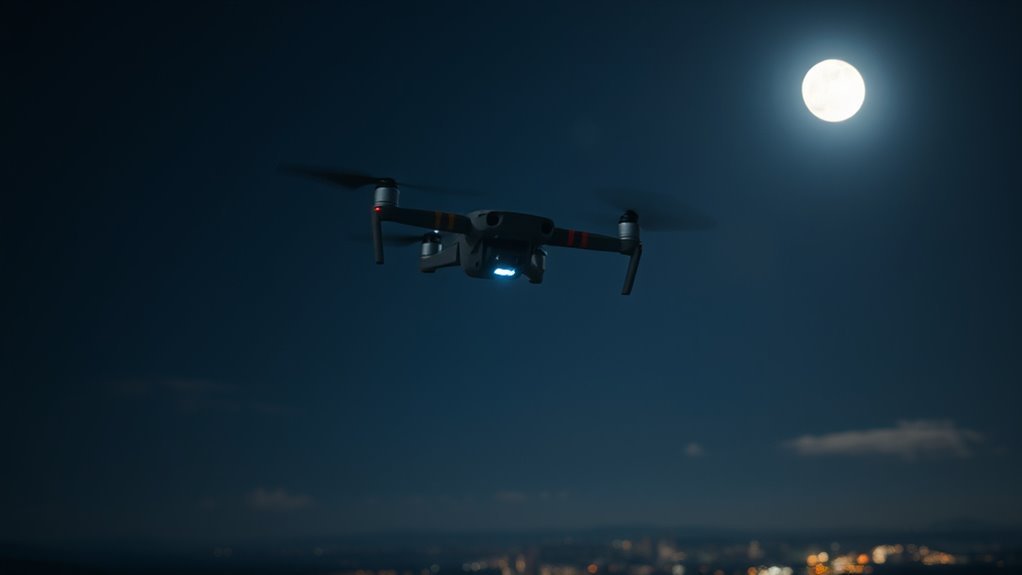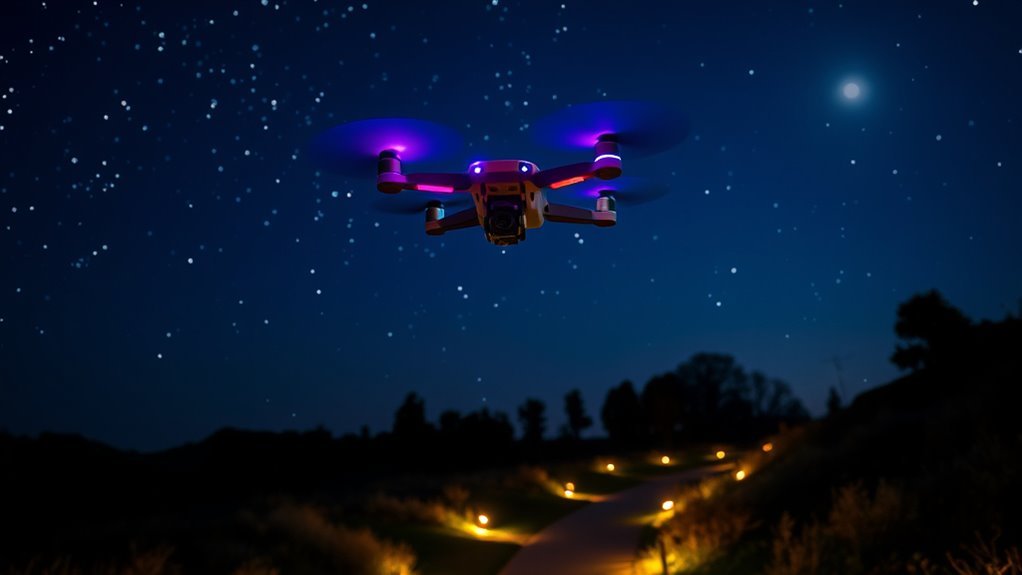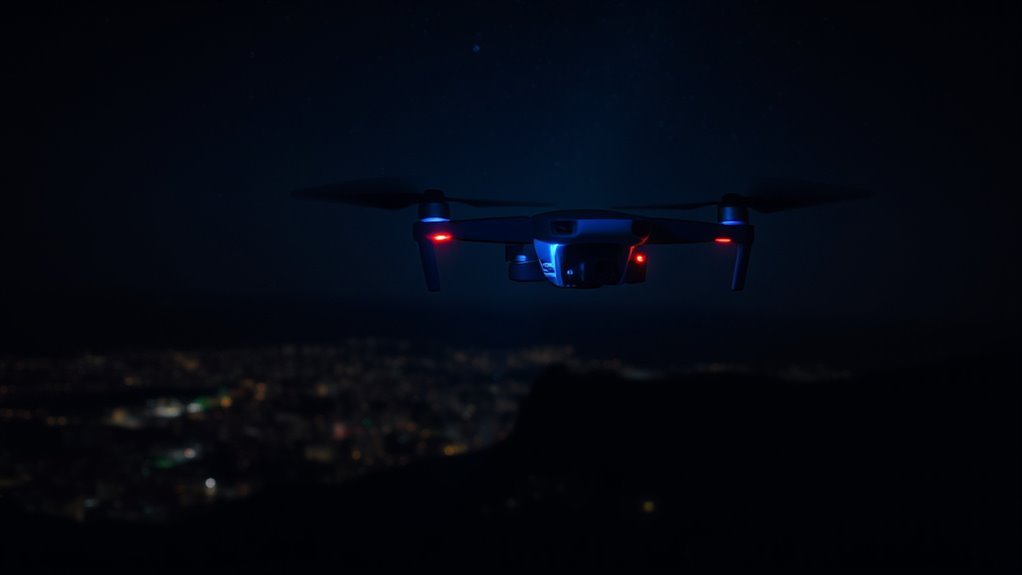To fly your drone at night, you must hold a Part 107 Remote Pilot Certificate and comply with FAA regulations, including specific lighting requirements. Your drone’s anti-collision lights should be visible for three statute miles and use distinguishable colors like red and green. Always maintain visual line of sight and check for no-fly zones before taking off. Additionally, make certain your equipment is suited for low-light conditions to enhance safety and performance. There’s more you should know about night flying.
Understanding FAA Regulations for Night Flying

Understanding the FAA regulations for flying drones at night is essential for any operator looking to expand their flying capabilities. To fly legally after dusk, you must possess a Part 107 Remote Pilot Certificate. Additionally, having an operational understanding of night vision technology is important for enhancing drone safety. This involves being aware of your drone’s limitations in low-light conditions and ensuring it’s equipped to handle such environments. You’re required to maintain visual line of sight, even in the dark, which makes familiarizing yourself with your drone’s lighting features significant. Be mindful of local laws and restrictions, as they may impose additional requirements. Following these regulations not only keeps you compliant but also promotes responsible drone operation under the night sky.
Required Lighting for Night Operations

When flying drones at night, having the right lighting is essential for safe operations. The FAA requires that your drone be equipped with anti-collision lights visible for at least three statute miles. These lights must use colors that are easily distinguishable; typically, red and green are used to indicate direction, while white lights help with night vision. You should verify that the lighting colors comply with regulations to maintain visibility and prevent accidents. Additionally, consider using additional lights if flying in areas with minimal ambient light, as they can enhance your awareness of the drone’s position. Proper lighting not only aids in navigation but also guarantees you’re flying responsibly while enjoying the freedom that comes with night operations.
Pre-Flight Checklist for Night Flights

Before you take off for a night flight, it’s essential to check local regulations to confirm compliance. Next, inspect your drone’s lighting requirements to secure proper visibility. Finally, verify the overall functionality of your drone to assure a safe and successful operation.
Check Local Regulations
How can you guarantee a safe night flight with your drone? Start by checking local regulations. Different areas may have specific laws regarding night flying and drone permits. Ignoring these could lead to fines or other penalties, which can restrict your freedom to fly.
| Aspect | Importance |
|---|---|
| Local Laws | Maintain compliance |
| Drone Permits | Avoid legal issues |
| Flight Zones | Know restricted areas |
| Insurance | Protect against liabilities |
| Community Guidelines | Respect local drone users |
Inspect Lighting Requirements
Ensuring your drone is equipped with the proper lighting is essential for safe night flights, as visibility can be greatly reduced in low-light conditions. You must utilize appropriate lighting technology to enhance drone visibility. This typically includes navigational lights, which should be easily visible from a distance and clearly indicate your drone’s orientation. Red and green lights are commonly used to signify direction, while white lights can help with overall visibility. Remember, your drone must be outfitted with lights that meet FAA regulations for night operations. Before taking off, double-check that all lights are functioning correctly and bright enough to maintain awareness of your drone’s position in the sky. Prioritize safety to enjoy the freedom of flying at night.
Verify Drone Functionality
While it’s exciting to fly your drone at night, verifying its functionality is essential for a safe experience. Before takeoff, make sure your drone’s battery performance is satisfactory, as low power can lead to malfunctions. Conduct a thorough check of your drone’s lights, GPS, and camera to guarantee everything is operational.
Here’s a quick pre-flight checklist:
| Item | Action Required | Status (Check/Uncheck) |
|---|---|---|
| Battery | Check charge level | |
| Lights | Test all indicators | |
| GPS | Verify connectivity | |
| Camera | Test functionality |
Maintaining Visual Line of Sight
When flying your drone at night, maintaining visual line of sight is essential for safety and compliance. This means you must always be aware of your drone’s position and surroundings, which can be challenging in low light conditions. Utilizing tracking tools can help enhance your situational awareness and guarantee you stay within regulatory guidelines.
Definition of Visual Line
Visual line of sight (VLOS) is a critical concept for drone operators, especially when flying at night. VLOS means you must maintain a direct line visibility to your drone without any visual limits obstructing your view. This guarantees you can see the drone’s orientation and position in real-time, allowing for safe operation. At night, this becomes more challenging due to reduced lighting and potential obstacles. You’re responsible for guaranteeing that you can see your drone clearly, making adjustments as necessary for safety. If you can’t maintain VLOS, you’ll need to ground your drone until conditions improve. Remember, flying within these regulations not only keeps you compliant but also enhances your freedom to enjoy the skies safely.
Importance of Awareness
Maintaining awareness of your drone’s position and surroundings is essential, especially at night when visibility is limited. Effective nighttime navigation requires you to keep your drone within your visual line of sight to guarantee drone safety. This means being aware of potential obstacles, other aircraft, and changes in environmental conditions.
| Key Aspect | Importance |
|---|---|
| Visual Line of Sight | Prevents collisions |
| Obstacle Awareness | Guarantees safe navigation |
| Environmental Factors | Affects flight performance |
Tools for Tracking
To effectively keep your drone within your visual line of sight at night, utilizing the right tools can greatly enhance your situational awareness. Employing tracking software is vital; it helps you monitor your drone’s location in real-time, ensuring it stays within your view. Look for software that integrates well with your drone’s system and provides accurate GPS data. High GPS accuracy is essential for night flights, as it reduces the risk of losing your craft in low light conditions. Additionally, consider using visual aids, like illuminated markers or LED lights on your drone, to increase visibility. By combining technology with smart flying practices, you can enjoy the freedom of flying at night while staying compliant with regulations.
Restrictions on Flight Altitude
While flying drones at night can open up new opportunities for aerial photography and recreational use, it’s crucial to adhere to specific altitude restrictions. The Federal Aviation Administration (FAA) enforces altitude limits to guarantee flight safety and minimize risks to other aircraft. Generally, you should keep your drone below 400 feet above ground level during nighttime flights. Exceeding this limit can lead to dangerous encounters with manned aircraft and potential legal repercussions. Additionally, always maintain visual line of sight with your drone, as this enhances flight safety and control. By respecting these altitude restrictions, you can enjoy the freedom of nighttime flying while safeguarding the safety of yourself and others in the airspace.
Avoiding No-Fly Zones at Night
Before you take off for a nighttime drone flight, it’s vital to guarantee you’re not entering any no-fly zones. This is especially significant when maneuvering through urban environments, where restricted areas can be abundant. Use mapping apps or official FAA resources to identify these zones clearly.
Here’s a quick reference table to help you spot common no-fly zones:
| No-Fly Zone Type | Description | Example Locations |
|---|---|---|
| Airports | Areas surrounding airports | Within 5 miles of any airport |
| Military Bases | Restricted airspace for security | Nearby military installations |
| National Parks | Protected wildlife areas | Yosemite, Yellowstone |
| Stadiums | Large gatherings | Sports events venues |
| Emergency Zones | Areas of disaster response | Natural disaster sites |
Stay informed and fly responsibly!
Safety Tips for Night Aerial Photography
Once you’ve confirmed that you’re clear of no-fly zones, it’s time to focus on safety tips for night aerial photography. Implementing proper drone safety measures is vital for a successful shoot. Here are three essential tips:
- Pre-Flight Check: Verify your drone’s lights are functioning and the battery is fully charged. This helps maintain visibility and control.
- Altitude Awareness: Fly at a safe altitude to avoid obstacles and guarantee you can react to any unforeseen issues.
- Use Night Photography Techniques: Experiment with longer exposure settings to capture stunning night shots, but keep an eye on your battery life.
Recommended Equipment for Night Flying
When flying drones at night, having the right equipment is vital for guaranteeing both safety and quality results. First, invest in drone cameras equipped with low-light capabilities or night vision features. These enhancements allow you to capture clear images in dark conditions, maximizing your creative potential. Additionally, having proper lighting on your drone, such as LED lights, is important; they help you maintain visibility and orientation while complying with FAA regulations. Also, consider using a reliable battery with extended flight time, as night flying can be more challenging, and you don’t want to risk losing power mid-flight. Ultimately, the right gear enhances your experience and guarantees you enjoy the freedom of flying safely at night.
Reporting Incidents and Compliance Issues
Although flying a drone at night can be exhilarating, it’s crucial to be aware of your responsibilities regarding incident reporting and compliance with regulations. To guarantee you’re flying responsibly, consider these compliance strategies:
- Document Incidents: Maintain thorough incident documentation for any mishaps, including dates, times, and circumstances.
- Notify Authorities: If you encounter serious issues—like collisions or injuries—report them to the FAA and local authorities promptly.
- Review Regulations: Regularly check for updates in drone laws and safety guidelines to stay compliant.
Frequently Asked Questions
Can I Fly My Drone Over Private Property at Night?
Daringly diving into drone regulations, you’ll need to navigate property rights. Flying over private property at night can be tricky. Always check local laws, as permission is paramount to prevent potential problems or penalties.
Are There Specific Insurance Requirements for Night Flying?
When it comes to night flying, you should check your insurance policies. Some require specific coverage for nighttime operations, ensuring you’re protected against potential risks. Always confirm your policy details before taking off.
What Is the Penalty for Flying a Drone at Night Illegally?
Flying a drone illegally at night’s like stepping into a dark alley—you risk serious consequences. Penalty guidelines vary, but you could face hefty fines or legal repercussions that restrict your flying freedom. Stay informed!
Do I Need a Special License to Fly at Night?
You don’t need a special license for night flights, but you must adhere to night flight regulations. Following drone safety guidelines is essential for ensuring safe operations and maintaining your freedom to fly responsibly.
Can I Use My Drone for Commercial Purposes at Night?
You can absolutely use your drone for commercial purposes at night, but you’ve got to follow strict nighttime regulations. Ensuring drone visibility is essential; without it, you risk losing your freedom to fly!

